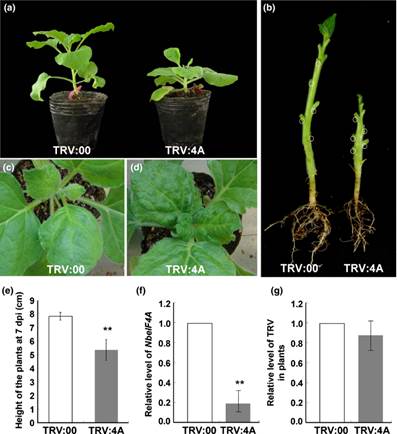植物病毒产生的症状到底与哪些宿主基因有关
病毒侵染会造成植株萎黄,生长迟缓,坏死或其他症状。叶绿体相关基因(ChRGs)的下调被认为与植株萎黄有关。然而尚缺乏实验证据支持这种观点。
浙江省农业科学院陈剑平院士课题组最近在国际知名期刊《新植物学家》(New Phytologist)上以“Identification and regulation of host genes related to Rice stripe virus symptom production”为题,报道了他们的最新研究成果,支持ChRGs与植株萎黄的相关性。燕飞研究员为本文的共同通讯作者。
课题组在水稻条纹病毒(RSV)侵染的本氏烟(Nicotiana benthamiana)上鉴定出一组差异表达的基因(DEGs)。研究人员采用烟草脆裂病毒(TRV)诱导基因沉默的方式逐一沉默基因,来考察75个表达下调基因对RSV症状产生的作用。
实验发现,沉默75个下调基因中的11个会造成植株萎黄,这11个中的9个基因是ChRGs(见图1)。其中沉默1个下调基因——编码真核翻译起始因子4A(eIF4A)会造成叶片扭曲和萎缩(见图2),这种现象可见于RSV侵染的本氏烟上。进一步地,研究人员发现,RSV RNA4上的一个区域与eIF4A mRNA的部分片段互补,高通量测序证实上述病毒区域来源的小干扰RNA(vsiRNAs)在病毒侵染的本氏烟上表达(图3)。当以人工微RNA表达vsiRNAs,它们可以靶向调控NbeIF4A mRNA



上述实验证据支持ChRGs与植株萎黄的相关性,并表明eIF4A参与RSV症状的发展(图4)。本研究也是第一份报告证明,直接来自植物病毒的siRNA可以靶向调控宿主基因。

图4 RSV症状产生与宿主基因互作的模型
(来源:联川生物)
Identification and regulation of host genes related to Rice stripe virus symptom production
Abstract Viral infections cause plant chlorosis, stunting, necrosis or other symptoms. The down-regulation of chloroplast-related genes (ChRGs) is assumed to be responsible for chlorosis. We identified the differentially expressed genes (DEGs) in Rice stripe virus (RSV)-infected Nicotiana benthamiana, and examined the contribution of 75 down-regulated DEGs to RSV symptoms by silencing them one by one using Tobacco rattle virus (TRV)-induced gene silencing. Silencing of 11 of the 75 down-regulated DEGs caused plant chlorosis, and nine of the 11 were ChRGs. Silencing of a down-regulated DEG encoding the eukaryotic translation initiation factor 4A (eIF4A) caused leaf-twisting and stunting that were visible on RSV-infected N. benthamiana. A region of RSV RNA4 was complementary to part of eIF4A mRNA and virus-derived small interfering (vsiRNAs) from that region were present in infected N. benthamiana. When expressed as artificial microRNAs, those vsiRNAs could target NbeIF4A mRNA for regulation. We provide experimental evidence supporting the association of ChRGs with chlorosis and show that eIF4A is involved in RSV symptom development. This is also the first report demonstrating that siRNA derived directly from a plant virus can target a host gene for regulation.
原文链接:http://onlinelibrary.wiley.com/doi/10.1111/nph.13699/epdf

